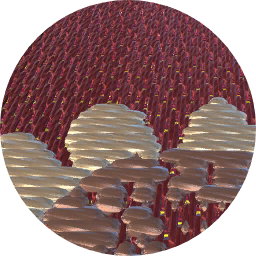Description
Servilleta of brocaded cotton with cotton and silk, Guatemala, 1875-1890
This is a women's servilleta, made from two pieces of equal width joined together with red and yellow cotton. Such cloths were used for a variety of purposes: as accessories like headcloths, scarves or kerchiefs, or as utility cloths to wrap around food, money, candles, incense or purchases or to cover baskets.
Both panels were woven one after the other on a backstrap loom and were then cut and joined side-by-side. Six different types of thread have been used in the pattern: red, orange, yellow, dark blue and brown cotton and yellow floss silk (now faded to cream). All silk in Guatemala, except for a small amount of 'wild' silk, was imported; it was expensive and was generally used only in small amounts. In this textile, small lengths of silk can be seen in the horse's head in the lower right hand corner.
Mr and Mrs Maudslay had attached narrow cotton sleeves to the reverse of this textile so that they could display it.
Servilleta of warp-faced plain weave cotton, and brocaded with cotton and silk.
1931 Description: Panel of cotton; loom embroidered in coloured cottons. The panel is in two equal pieces joined together with braid-stitching in red and yellow cotton. Each half is bordered at either side with woven stripes of brown, red, blue and yellow. Each half has in the centre a conventional double-headed eagle and above this, in the left half are conventionalised figures on horseback, below it are two geometrical medallions, all in red, yellow and blue. The right half has, above the central patterns, four birds and, below it, two figures of horseback. The panel has double-turning stitch in red and yellow cotton at the top, and buttonhole stitch in red at the lower edge. The left hand half of the panel is illustrated in Maudslay's 'A Glimpse at Guatemala' p.42.
1975 Description: Women's old style servilleta from Chichicastenango. This piece would have been used by women - to carry food, wrap money in, carry candles, incense etc.. A similar piece is illustrated in L M O'Neale's 'Textiles of Highland Guatemala' (1945 fig. 110b).
Warp faced white cotton plain weave with coloured stripes at the edges of both pieces. The light brown stripes are woven with the undyed, natural brown cotton known as Cuyuscate or Ixaco (Gossypium Mexicanum). The design is done in double-faced brocading technique (known also as loom embroidery, laid-in etc), done with several pattern yarns used together in one pick, making the design stand out thickly from the groundcloth. The servilleta is made from two pieces of equal size woven on a backstrap loom, therefore with 4 selvedges each. The embroidered seam is called a randa.
Technical Details (1995):
A narrow cotton sleeve has been applied on the back along the top and bottom edges (By the Maudslays? For display?); this was remove in 1995 but has left slight marks.
Warp-faced plain weave.
Warp: 54 threads per inch. White, brown, dark blue, orange, red and black cotton arranged to form stripes; all are Z-spun, unplied; single threads of dark blue, brown and black per shed; 2 parallel threads of red and orange per shed; single threads of white cotton are used except in a stripe to the left of the right hand panel and to the right of the left hand panel where 2 parallel threads are used per shed.
Weft: 25 threads per inch. White cotton, Z-spun, unplied. There are three bands of brown cotton weft (Z-spun, unplied) at both lower and upper ends.
Lower Edge: uncut but rolled under and towards the front and secured with red cotton blanket stitch,
Upper Edge: cut, rolled under and towards the front and secured with red and orange cotton forming a zigzag.
Both panels were woven together, cut and then joined side-by-side.
Brocading: number of different types/colours of thread = 6. Red cotton (Z6S), orange cotton (Z6S), yellow cotton (Z6S), yellow floss silk (faded to cream - probably 2 parallel threads per shed), dark blue cotton (Z3S), brown cotton (Z3S). The cotton threads are loosely plied and often fall into parallel threads.
Randa: pieces joined together edge-to-edge with blocks of red and orange cotton giving the effect of a buttonhole stitch.
Design: in both panels the animals face away from the central seam.
Women's Servilleta, made from two pieces of equal width joined together with red and yellow cotton. Mr & Mrs Maudslay had attached narrow cotton sleeves to the reverse of this textiles so that they could display it.
Both panels were woven together, cut and then rejoined side-by-side. Six different types of thread have been used in the pattern: red, orange, yellow, dark blue and brown cotton and yellow floss silk (now faded to cream). All silk in Guatemala, except for a small amount of 'wild' silk, was imported; it was expensive and was generally used only in small amounts. In this textiles, small lengths of silk can be seen in the horse's head in the lower right hand corner. []










